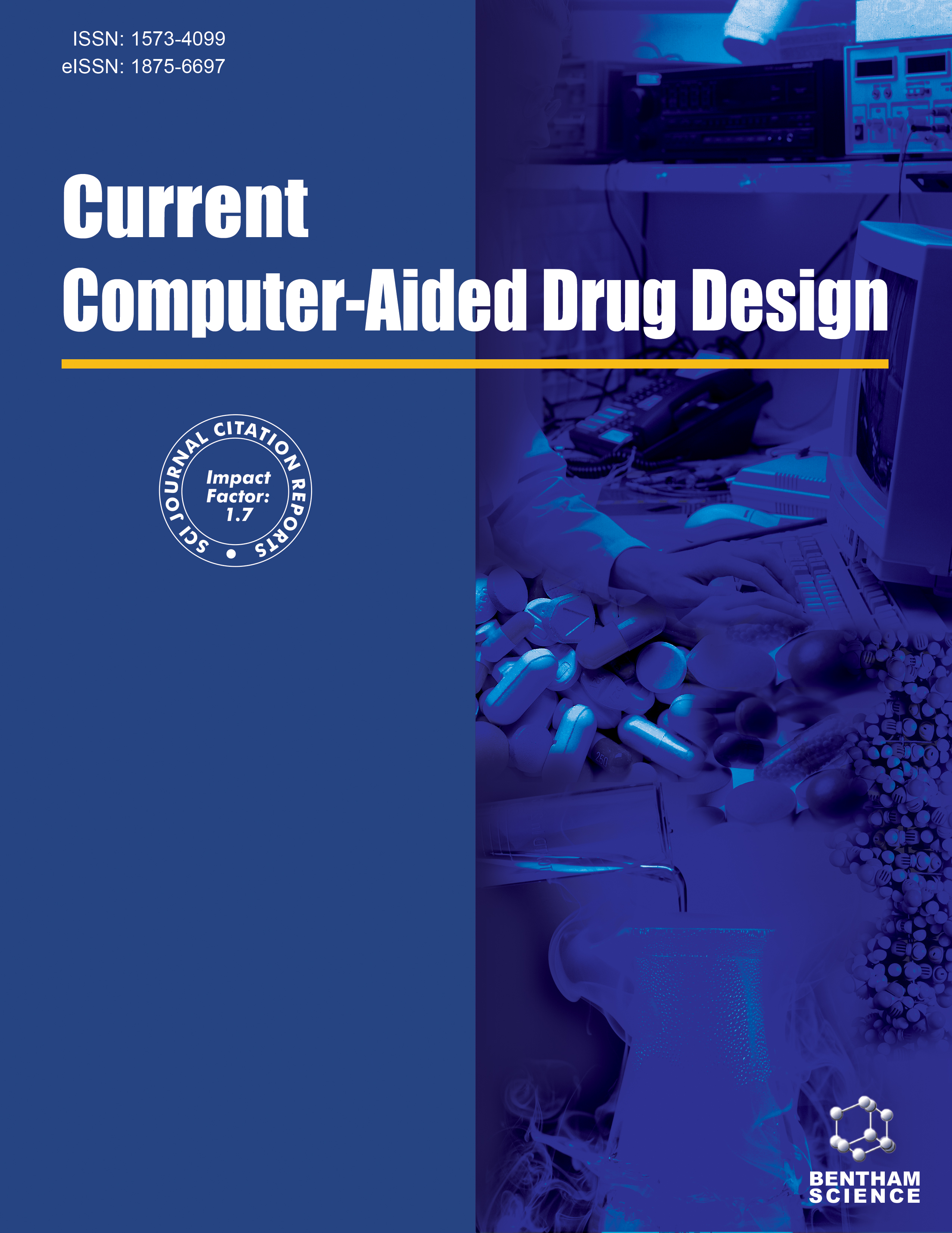- Home
- A-Z Publications
- Current Computer - Aided Drug Design
- Previous Issues
- Volume 11, Issue 3, 2015
Current Computer - Aided Drug Design - Volume 11, Issue 3, 2015
Volume 11, Issue 3, 2015
-
-
Analysis of Drug Design for a Selection of G Protein-Coupled Neuro- Receptors Using Neural Network Techniques
More LessAuthors: Claus Agerskov, Rasmus M. Mortensen and Henrik G. BohrA study is presented on how well possible drug-molecules can be predicted with respect to their function and binding to a selection of neuro-receptors by the use of artificial neural networks. The ligands investigated in this study are chosen to be corresponding to the G protein-coupled receptors μ-opioid, serotonin 2B (5-HT2B) and metabotropic glutamate D5. They are selected due to the availability of pharmacological Read More
-
-
-
Interaction studies of Withania somnifera’s key metabolite Withaferin A with different receptors associated with cardiovascular disease
More LessWithania somnifera commonly known as Ashwagandha in India is used in many herbal formulations to treat various cardiovascular diseases. The key metabolite of this plant, Withaferin A was analyzed for its molecular mechanism through docking studies on different targets of cardiovascular disease. Six receptor proteins associated with cardiovascular disease were selected and interaction studies were performed with Withaf Read More
-
-
-
Ligand and Structure Based Models for the Identification of Beta 2 Adrenergic Receptor Antagonists
More LessLigand bound beta 2 adrenergic receptor (β2AR) crystal structures are in use for screening of compound libraries for identifying inducers and blockers. However, in case of G protein coupled receptors (GPCR), docking and binding energy (BE) calculations are not enough to discriminate agonist and antagonists. Absence of a reliable model for discriminating β2AR antagonist is still a major hurdle. Docking of known antago Read More
-
-
-
Comparison of performance of docking, LIE, metadynamics and QSAR in predicting binding affinity of benzenesulfonamides
More LessAuthors: Vytautas Raškevišius and Visvaldas KairysThe design of inhibitors specific for one relevant carbonic anhydrase isozyme is the major challenge in the new therapeutic agents development. Comparative computational chemical structure and biological activity relationship studies on a series of carbonic anhydrase II inhibitors, benzenesulfonamide derivatives, bearing pyrimidine moieties are reported in this paper using docking, Linear Interaction Energy (LIE), Read More
-
-
-
Combined 3D-QSAR and molecular docking study for identification of diverse natural products as potent Pf ENR inhibitors
More LessAuthors: Preeti Wadhwa, Debasmita Saha and Anuj SharmaAn in-house library of 200 molecules from natural plant products was designed in order to evaluate their binding to Plasmodium ACP enoyl reductase (ENR), a promising biological target for antimalarial chemotherapeutics. The binding site of PfENR was explored computationally and the molecules were docked using AutoDock. Furthermore, the top-ranked scaffolds from docking studies were also compared with known Pf Read More
-
-
-
Molecular Modeling Investigation of Folic Acid Conjugation to MDM2 Inhibitors for Enhanced Cellular Uptake and Target Binding
More LessAuthors: Sachin P. Patil, Cassidy R. Kerezsi, Bridget M. Hicks and Alexandra H. JednorskiThe activation of tumor suppressor p53 protein through inhibition of its interaction with the oncogenic Murine Double Minute 2 (MDM2) protein presents a novel therapeutic strategy against cancer. Accordingly, several small-molecule inhibitors have been developed that mimic three hydrophobic groups of p53 involved in p53-MDM2 binding and thus block the p53-binding pocket on MDM2. Interestingly, presence of a f Read More
-
-
-
FERN Ethnomedicinal Plant Database: Exploring fern ethnomedicinal plants knowledge for computational drug discovery
More LessAuthors: Sambhaji B. Thakar, Pradnya N. Ghorpade, Manisha V. Kale and Kailas D. SonawaneFern plants are known for their ethnomedicinal applications. Huge amount of fern medicinal plants information is scattered in the form of text. Hence, database development would be an appropriate endeavor to cope with the situation. So by looking at the importance of medicinally useful fern plants, we developed a web based database which contains information about several group of ferns, their medicinal uses, chemic Read More
-
-
-
Rational Design and Optimization of Trypsin Inhibitory Peptides with Antibacterial Activity
More LessAuthors: Xiaoqin Liu, Zhengling Wang, Jingming Cui and Wenli SuSmall natural or synthetic peptides have been reported to exhibit potent inhibitory capability against trypsin, some of which were also found to have antibacterial potency. Here, we described a successful application of in silico-in vitro integrated approach to rationally design and optimize bifunctional peptides with both trypsin inhibitory and antimicrobial activities. In the procedure, computer-aided methods including protei Read More
-
-
-
Novel Thiosemicarbazide Hybrids with Amino Acids and Peptides Against Hepatocellular Carcinoma: A Molecular Designing Approach Towards Multikinase Inhibitor
More LessAuthors: Shinu Chacko and Subir SamantaHepatocellular Carcinoma is the most common primary malignant tumor of the liver. Development of multidrug resistance is the main obstacle to the success of anticancer drugs. In this study, designing and docking study of thiosemicarbazide hybrids with amino acids or peptides against hepatocellular carcinoma was performed since hybrids of biologically active compounds with amino acids or peptides may show target s Read More
-
Volumes & issues
-
Volume 21 (2025)
-
Volume 20 (2024)
-
Volume 19 (2023)
-
Volume 18 (2022)
-
Volume 17 (2021)
-
Volume 16 (2020)
-
Volume 15 (2019)
-
Volume 14 (2018)
-
Volume 13 (2017)
-
Volume 12 (2016)
-
Volume 11 (2015)
-
Volume 10 (2014)
-
Volume 9 (2013)
-
Volume 8 (2012)
-
Volume 7 (2011)
-
Volume 6 (2010)
-
Volume 5 (2009)
-
Volume 4 (2008)
-
Volume 3 (2007)
-
Volume 2 (2006)
-
Volume 1 (2005)
Most Read This Month
Article
content/journals/cad
Journal
10
5
false
en


